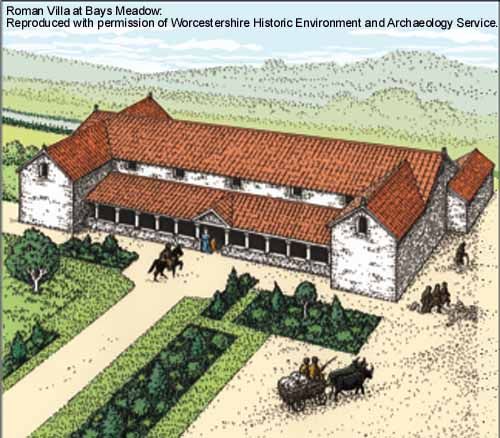More information about Dodderhill in Roman times
Archaeological excavations have revealed evidence of one Roman fort in Dodderhill, as well as an earlier marching camp, and a major villa indicating the importance of the local salt industry.
The brine springs were used in the Iron Age and this is the basis for the growth of the Roman settlement of Salinae which lay on the River Salwarpe with roads radiating out to Gloucester, Alcester, Metchley and Wroxeter, and which extended into the parish of Dodderhill.
Salt was a product of considerable economic value in the Roman Empire and its extraction was often carried out under imperial control. The recognition of its importance probably influenced the decision to put a marching camp here in about AD 47, soon after the invasion of AD 43. (This camp was partly under the later Roman Crutch Lane and partly to its east side.) A larger fort was constructed in the AD 60s on the higher ground now occupied by St Augustine’s Church. From this commanding position overlooking the valley and close to the main road junction, the fort would have been in the ideal position to supervise local labour at the brine springs below. The ramparts round this later fort were probably laid out to be defended by a company of archers. The fort was occupied for quite a short period during the reign of the emperor Nero, and may have been garrisoned during the troubled period of Boudiccan revolt when some Britons tried to eject the Romans from the country. Military occupation ceased about AD 67. We have no archaeological evidence for the size or layout of the Roman settlement around the brine springs.
A substantial 2nd century villa complex was revealed in Bays Meadow by excavations in 1954-5 and 1967-77. The building of the villa and the increased exploitation of brine may have been closely linked. In the Roman Empire, mineral resources, such as salt, were treated as imperial monopolies under the control of the state. By the 2nd century their working was being leased out to entrepreneurs. The villa could, therefore, have been the residence of a wealthy imperial administrator or entrepreneur controlling the production of salt.

The Roman Villa at Bays Meadow
Some disruption to the salt industry may have occurred in the late 3rd century, when the principal villa burned to the ground. This coincided with a period of rebellion affecting western provinces in the Empire and it is possible that the villa became a focus for anti-Roman feeling. A warning of impending danger must have been known in advance, as a ditch and rampart defences were thrown up around the villa just before disaster struck. Activity at the villa continued into the 4th century, although on the decline.
In addition to these professionally excavated Roman sites, the Dodderhill Parish Survey Project has undertaken further research and has discovered that in contrast with earlier periods the evidence for Roman activity is quite widespread across Dodderhill parish. The evidence usually takes the form of Roman pottery sherds which have been identified in most places where fieldwalking has been undertaken. Concentrations vary and in some cases the Roman finds are rare (ie in the fields to the west of Crutch Lane, and at Rashwood). Here they will probably represent areas of arable cultivation in Roman times, where the domestic waste has been collected and spread on the fields to maintain soil fertility. The relative frequency of the Roman finds, therefore, indicates the extent to which arable farming was achieved on the north side of Droitwich. The area under cultivation in this period seems to have been large, though as the evidence covers a period of nearly 400 years, it is impossible to say what the extent of arable was in any one year, or in any specific period from the mid 1st to early 5th century.
In a field to the east of Crutch Lane Roman pottery finds were plentiful during fieldwalking in 1997, and included material representing the whole of the Roman period. There were some classic examples of the locally made Severn Valley ware, which is the usual domestic pottery here. This could clearly be identified as the site of well established occupation, and may represent a farmstead. Typically the local Dodderhill inhabitant had a very good choice of pottery types. A high proportion was from the Malvern area (Severn Valley ware), while other pottery was from Dorset (cooking pots known today as black burnished ware), Oxfordshire (imitation samian ware, and mixing/grinding bowls), and Staffordshire (mixing/grinding bowls). Imported pottery was also found which had been made in Roman Gaul. A high percentage of the Severn Valley ware was early in date, suggesting that settlement flourished here in the 1st-2nd century AD.
The absence of any building materials may well indicate that the farmstead retained its native British character throughout, and was not converted into a Romanised house using ceramic tiles and bricks. It may have benefited from its proximity to Droitwich by supplying food to the salt makers as well as to the inhabitants of the villa at Bays Meadow but of course this remains uncertain. The villa at Bays Meadow was an exceptional site which must have exercised a great deal of influence over the surrounding area, including probably Dodderhill, which is likely to have been part of an associated agricultural estate. Its original purpose may have been to oversee the salt making. Judging by the large number of coins found close to the villa buildings, one of its functions may have been a specialised market where salt sellers bought their salt directly from the villa owner.